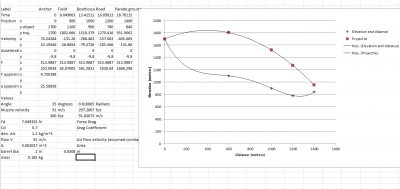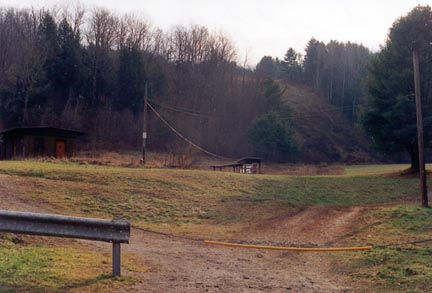Page 1 of 1
Specific range analysis
Posted: Fri Apr 04, 2014 8:52 pm
by thunderskunk
Hello folks!
So I made this in my spare time. It's an excel sheet for projectile motion.I can't attach the spreadsheet, so here's a picture:

- Example of my own situation
This is a cutaway view of the range I want to accomplish in the metric system. We want to haul our cannon up the hill and hit a smaller hill down below.
This excel sheet is SUPPOSED to figure air resistance into this whole trajectory thing, but it's a differential equation, and excel doesn't do that sort of thing.
So here's the thing; that model works without air resistance. It's a physics I problem, and it's wrong.
The question is; Can I make this work? Not the program, the range. I'm trying to shoot 1400 meters with an 800 meter drop.
Thanks for the input!
Re: Specific range analysis
Posted: Sat Apr 05, 2014 12:01 am
by Ragnarok
thunderskunk wrote:The question is; Can I make this work? Not the program, the range. I'm trying to shoot 1400 meters with an 800 meter drop.
Judging by your input data, this isn't a particularly aerodynamic projectile you've got in mind.
I've not got the time right now to swing any proper calculation at this, but my guess is "no".
Even with the altitude advantage, any projectile that unaerodynamic would have slowed hugely inside the first couple of hundred metres, so simply wouldn't have the velocity to cover the large remaining distance.
In any case, I should note that even an eagle's eyesight would struggle to track a 5 cm projectile from 1400 metres off, so even if it is possible, it won't be all that impressive to watch.
Re: Specific range analysis
Posted: Sat Apr 05, 2014 12:38 am
by dajoro
FIRST: Show me your "cannon" or "gun" device ,
SECOND: Make sure that "smaller hill" ain't sombody's house man.
THIRD: "Programs" and "spreadsheets" do not calculate how awesome 1400 meters with an 800 meter drop is.
Re: Specific range analysis
Posted: Sat Apr 05, 2014 7:09 am
by thunderskunk

- norwichbegareaad.jpg (31.98 KiB) Viewed 2352 times
This is just the bottom of our ski area face. There is no longer a ski lift, and that building was torn down, we're good to go for the range even if it could go that far.
As for the sight-line, that's why we have forward observers down range!
Re: Specific range analysis
Posted: Sat Apr 05, 2014 7:14 am
by thunderskunk
Sorry, this is a better picture. Again, those buildings are long gone and the ski area is mostly overgrown
Re: Specific range analysis
Posted: Sat Apr 05, 2014 9:01 am
by Ragnarok
Time for me to swing some actual calculation at this...
The integration here isn't that difficult. The very useful number here is as follows: (Air density * Cd * Cross sectional area) / (Mass * 2)
This is the specific drag area (we'll call it the SDA for short), final units are m^-1. Lower numbers are more aerodynamic.
Depending on how you manipulate it, it can tell you a lot. Disregarding wind and gravity:
Velocity after x metres of flight is MV / (EXP(SDA) ^ x)
Distance travelled after y seconds of flight is LN(1+(MV * y * SDA))/ SDA
You can combine the two to get the velocity after y seconds.
Now, the disregarding of gravity... that's not too much of a problem on a flat trajectory, such as a rifle shot, as the difference in the gravitational potential energy is negligible.
This kind of lobbed "mortar" shot is a somewhat different matter, but it at least gives a ballpark.
The SDA for this projectile is about 0.0046.
So, 1400 metres of flight from a MV of 91 m/s will take this projectile about... erm... 1500 seconds to cover (25 minutes), and will have slowed it to a velocity of about 0.15 m/s.
Now, even with an 800 metre height advantage, I can fairly safely say the projectile is not going to be airborne for 25 minutes.
A back of the envelope estimation shows the projectile will have roughly 20 seconds of hang time (assuming an apogee of about +200 metres and a landing at -800 m), give or take a few either way, under which circumstances, you'll need to fire it at somewhere about 7000 m/s.
Of course, there are a few problems with this:
1) This will involve velocities in all of the subsonic, transonic, supersonic and hypersonic regions, so the drag coefficient we used is now inaccurate.
2) The projectile has a fairly high chance of breaking apart or incinerating in flight. This is approaching re-entry velocities.
3) It'd be way more impressive to use the thing to destroy armoured vehicles.
... in short, if you want to hit that hill, you're going to need something considerably more aerodynamic, and preferably up the velocity by a reasonable chunk too.
That range at ~100 m/s is potentially possible, but it'd be a lot easier at 150+ m/s.